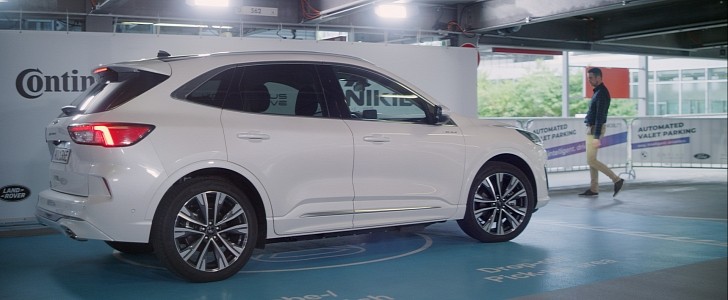Tired of searching for a parking spot in crowded places? Is it uncomfortable trying to squeeze in and out of your car? Welcome to everyday driving. Thing is, it doesn’t have to be all that stressful anymore, at least not the way technology has been progressing during these past few years, and some carmakers are already looking into how we might solve these issues for good.
Take Ford for example. As part of a collaboration with the German Association of the Automobile Industry, the carmaker has teamed up with infrastructure providers and tech firms like Bosch in order to demonstrate the potential for a connected vehicle to communicate with a car park infrastructure to not just find a space, but for the former to park itself as well.
This technology is just in its early stages of research and demonstration, but ideally it should manage to take all the stress out of parking. Ford will demonstrate Automated Valet Parking at IAA in Munich next week, between September 6-12.
One of the issues drivers face in Europe for example is the size of a parking spot, where the standard is 2.44 meters (8 feet) by 4.88 meters (16 feet), and while cars have grown over the years, these spaces have stayed the same. Ford is looking to provide a solution though, as Automated Valet Parking could allegedly enable up to 20% more vehicles to be parked in the average car park.
Here’s how it works. It starts with the sensor technology that you first must set up in the car park. This is what eventually controls your vehicle and all the traffic inside the parking area. So, say you arrive at the car park – you then go to the designated area and use your FordPass app to start the automated guidance process.
The car park sensors will then recognize and localize the vehicle and guide its maneuver. Naturally, if the infrastructure detects something in the car’s path, like a pedestrian or another vehicle, it immediately stops the car.
Other benefits could include having your parked car become a personal parcel drop-off point, as well as having the vehicle returned to you to the designated area, thus saving you from having to walk all the way back to where you parked.
While this technology is still in its infancy, from what we can tell it looks very promising. There is of course one caveat to consider. In order to pair your car to a parking structure’s Automated Valet system, the car itself must have an automatic transmission, ESC, an electric parking brake and assisted steering.
This technology is just in its early stages of research and demonstration, but ideally it should manage to take all the stress out of parking. Ford will demonstrate Automated Valet Parking at IAA in Munich next week, between September 6-12.
One of the issues drivers face in Europe for example is the size of a parking spot, where the standard is 2.44 meters (8 feet) by 4.88 meters (16 feet), and while cars have grown over the years, these spaces have stayed the same. Ford is looking to provide a solution though, as Automated Valet Parking could allegedly enable up to 20% more vehicles to be parked in the average car park.
Here’s how it works. It starts with the sensor technology that you first must set up in the car park. This is what eventually controls your vehicle and all the traffic inside the parking area. So, say you arrive at the car park – you then go to the designated area and use your FordPass app to start the automated guidance process.
The car park sensors will then recognize and localize the vehicle and guide its maneuver. Naturally, if the infrastructure detects something in the car’s path, like a pedestrian or another vehicle, it immediately stops the car.
Other benefits could include having your parked car become a personal parcel drop-off point, as well as having the vehicle returned to you to the designated area, thus saving you from having to walk all the way back to where you parked.
While this technology is still in its infancy, from what we can tell it looks very promising. There is of course one caveat to consider. In order to pair your car to a parking structure’s Automated Valet system, the car itself must have an automatic transmission, ESC, an electric parking brake and assisted steering.












